
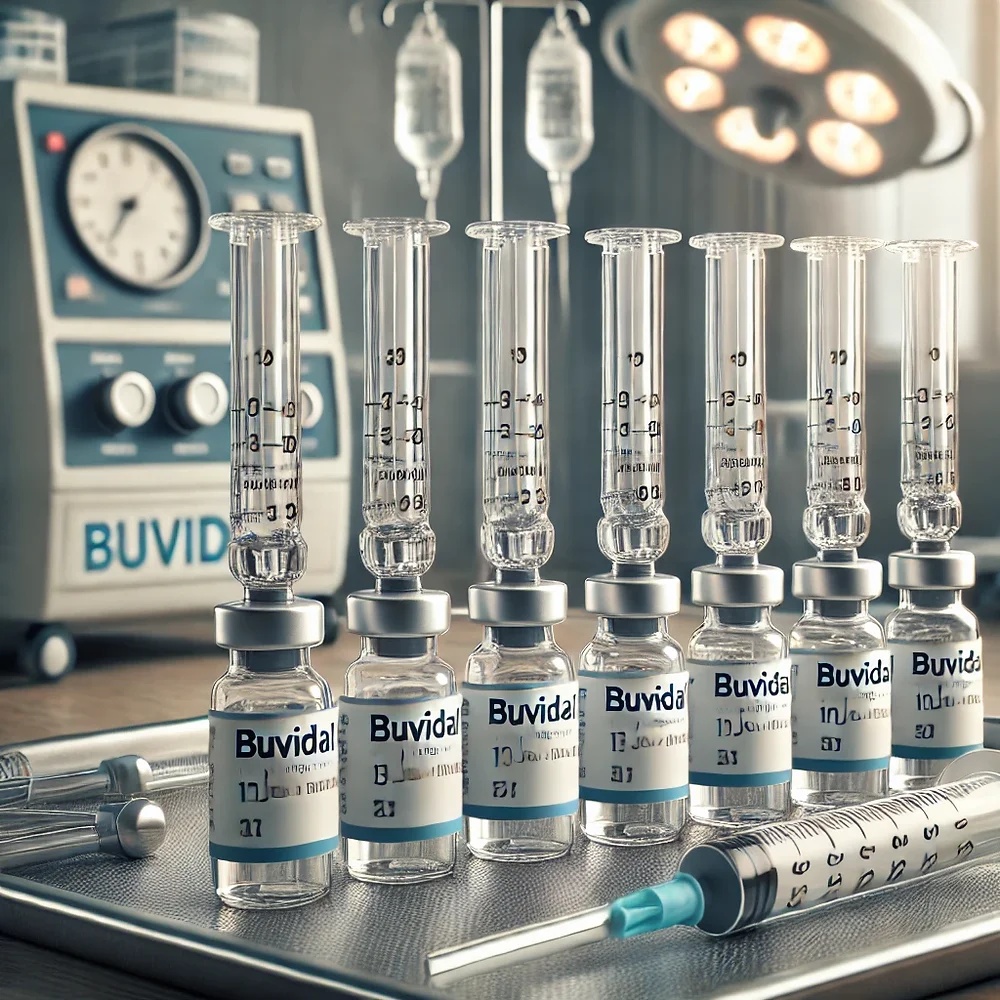
BUVIDAL 16 mg SOLUÇÃO INJETÁVEL DE LIBERTAÇÃO PROLONGADA

Pergunte a um médico sobre a prescrição de BUVIDAL 16 mg SOLUÇÃO INJETÁVEL DE LIBERTAÇÃO PROLONGADA

Como usar BUVIDAL 16 mg SOLUÇÃO INJETÁVEL DE LIBERTAÇÃO PROLONGADA
Introdução
Prospecto: informação para o utilizador
Buvidal 8mg solução injetávelde libertação prolongada
Buvidal 16mg solução injetávelde libertação prolongada
Buvidal 24mg solução injetávelde libertação prolongada
Buvidal 32mg solução injetávelde libertação prolongada
Buvidal 64mg solução injetávelde libertação prolongada
Buvidal 96mg solução injetávelde libertação prolongada
Buvidal 128mg solução injetávelde libertação prolongada
Buvidal 160mg solução injetávelde libertação prolongada
buprenorfina
Leia todo o prospecto atentamente antes de começar a usar este medicamento, porque contém informações importantes para si.
- Conserva este prospecto, porque pode ter que voltar a lê-lo.
- Se tiver alguma dúvida, consulte o seu médico, farmacêutico ou enfermeiro.
- Se experimentar efeitos adversos, consulte o seu médico, farmacêutico ou enfermeiro, mesmo que se trate de efeitos adversos que não aparecem neste prospecto. Ver secção 4.
Conteúdo do prospecto
- O que é Buvidal e para que é utilizado
- O que necessita de saber antes de começar a receber Buvidal
- Como é administrado Buvidal
- Posíveis efeitos adversos
- Conservação de Buvidal
- Conteúdo do envase e informação adicional
1. O que é Buvidal e para que é utilizado
Buvidal contém o princípio ativo buprenorfina, que é um tipo de medicamento opioide. É utilizado para tratar a dependência de opioides em doentes que também estão a receber apoio médico, social e psicológico.
Buvidal está indicado em adultos e adolescentes de 16 anos ou mais.
2. O que necessita de saber antes de começar a receber Buvidal
Não use Buvidal:
- se é alérgico à buprenorfina ou a algum dos outros componentes deste medicamento (incluídos na secção 6)
- se tem problemas respiratórios graves
- se tem problemas de fígado graves
- se tem uma intoxicação por álcool ou tem tremores, suor, ansiedade, confusão ou alucinações provocados pelo álcool
Advertências e precauções
Consulte o seu médico antes de usar Buvidal se tiver:
- asma ou outros problemas respiratórios
- qualquer doença do fígado como hepatite
- insuficiência renal grave
- certos problemas do ritmo cardíaco (síndrome de QT longo ou intervalo QT prolongado)
- hipotensão
- sofreu recentemente uma lesão na cabeça ou uma doença no cérebro
- distúrbio urinário (em especial associado a um aumento do tamanho da próstata em homens)
- problemas de tireoide
- um distúrbio corticosuprarrenal (p. ex., doença de Addison)
- problemas de vesícula
- depressão ou outras doenças que são tratadas com antidepressivos. O uso destes medicamentos juntamente com Buvidal pode provocar síndrome serotoninérgica, uma doença potencialmente mortal (ver “Outros medicamentos e Buvidal”).
- se alguma vez teve uma reação alérgica ao látex
Aspectos importantes que se devem ter em conta
- Problemas de respiração:Algumas pessoas morreram devido a uma respiração muito lenta ou superficial provocada ao tomar buprenorfina com outros depressores do sistema nervoso central (substâncias que retardam algumas atividades cerebrais), como as benzodiazepinas, o álcool ou outros opioides.
- Sonolência:Este medicamento pode provocar sonolência, em especial quando é utilizado com álcool ou outros depressores do sistema nervoso central (substâncias que retardam algumas atividades cerebrais), como benzodiazepinas, outros medicamentos que reduzem a ansiedade provocam sonolência, pregabalina ou gabapentina.
- Dependência:Este medicamento pode causar dependência.
- Dano hepático:Podem ocorrer danos no fígado com buprenorfina, em especial quando é usada indevidamente. Isso também pode ocorrer devido a infecções víricas (hepatite C crónica), abuso do álcool, anorexia (distúrbio alimentar) ou uso de outros medicamentos que podem danificar o fígado. O seu médico pode pedir-lhe que se realize análises de sangue com regularidade para controlar o estado do seu fígado. Informe o seu médico se tiver problemas de fígado antes de iniciar o tratamento com Buvidal.
- Sintomas de abstinência:Este medicamento pode provocar sintomas de abstinência se o tomar menos de 6 horas após ter consumido um opioide de ação curta (p. ex. morfina, heroína) ou menos de 24 horas após ter consumido um opioide de ação prolongada, como a metadona.
- Tensãoarterial:Este medicamento pode provocar um descenso súbito da sua tensão arterial, o que provocaria uma sensação de mareio se se levantasse demasiado rápido quando está sentado ou deitado.
- Diagnóstico de afecções médicas não relacionadas:Este medicamento pode mascarar a dor, o que poderia dificultar o diagnóstico de algumas doenças. Não se esqueça de informar o seu médico que está a receber este medicamento.
- Distúrbios respiratórios relacionados com o sono:Buvidal pode causar distúrbios respiratórios relacionados com o sono, tais como apneia de sono (pausas respiratórias durante o sono) e hipoxemia relacionada com o sono (níveis baixos de oxigénio no sangue). Os sintomas podem incluir pausas respiratórias durante o sono, despertares noturnos devidos à dificuldade para respirar, dificuldade para manter o sono ou sonolência excessiva durante o dia. Contacte o seu médico se você ou outra pessoa observa estes sintomas. O seu médico poderia considerar uma redução da dose.
Tolerância, dependência e adicção
Este medicamento contém buprenorfina, uma substância opioide. O uso repetido de opioides pode diminuir a eficácia do medicamento (o seu organismo se acostuma com o medicamento, isto é o que se conhece como tolerância). O uso repetido de buprenorfina também pode causar dependência, abuso e adicção, o que pode dar lugar a uma sobredose potencialmente mortal.
A dependência ou a adicção podem fazer com que se sinta que já não tem o controlo da quantidade de medicamento que precisa usar ou com que frequência deve usá-lo.
O risco de se tornar dependente ou adicto varia de acordo com a pessoa. Pode apresentar um maior risco de se tornar dependente ou adicto à buprenorfina se:
- Você ou algum membro da sua família tem antecedentes de abuso ou dependência do álcool, medicamentos de venda com receita ou substâncias ilícitas (“adicção”).
- É fumador.
- Alguma vez teve problemas com o seu estado de ânimo (depressão, ansiedade ou um distúrbio de personalidade) ou recebeu tratamento de um psiquiatra para outras doenças mentais.
Se nota algum dos seguintes sinais enquanto toma buprenorfina, poderia ser um sinal de que se tornou dependente ou adicto:
- Precisa usar o medicamento durante mais tempo do que o recomendado pelo seu médico.
- Precisa usar mais doses do que a recomendada.
- Está a usar o medicamento por razões distintas das prescritas, por exemplo, “para se acalmar” ou “para ajudar a dormir”.
- Fez tentativas repetidas e sem sucesso de deixar ou controlar o uso do medicamento.
- Não se sente bem quando deixa de usar o medicamento e se sente melhor quando volta a usá-lo (“sintomas de abstinência”).
Se nota algum dos seguintes sinais enquanto toma buprenorfina, poderia ser um sinal de que se tornou dependente ou adicto:
- Precisa usar o medicamento durante mais tempo do que o recomendado pelo seu médico. - Precisa usar mais doses do que a recomendada.
- Está a usar o medicamento por razões distintas das prescritas, por exemplo, “para se acalmar” ou “para ajudar a dormir”.
- Fez tentativas repetidas e sem sucesso de deixar ou controlar o uso do medicamento.
- Não se sente bem quando deixa de usar o medicamento e se sente melhor quando volta a usá-lo (“sintomas de abstinência”).
Se nota algum destes sinais, fale com o seu médico para abordar a estratégia terapêutica mais adequada no seu caso, incluindo quando é apropriado deixar de usar e como fazer de forma segura (ver secção 3 “Se interrompe o tratamento com Buvidal”).
Crianças e adolescentes
Buvidal não deve ser usado em crianças menores de 16 anos. O seu médico o supervisionará com maior atenção se for adolescente (16 a 17 anos).
Outros medicamentos e Buvidal
Informe o seu médico se está a utilizar, utilizou recentemente ou poderia ter que utilizar qualquer outro medicamento.
Alguns medicamentos podem aumentar os efeitos adversos de Buvidal e podem causar reações muito graves.
É especialmente importante que informe o seu médico se está a tomar:
- benzodiazepinas(utilizadas para tratar a ansiedade ou os distúrbios do sono). Tomar doses muito altas de uma benzodiazepina juntamente com Buvidal pode provocar a morte porque ambos os medicamentos podem fazer com que a respiração seja mais lenta e superficial (depressão respiratória). Se necessita de uma benzodiazepina, o seu médico prescrever-lhe-á a dose correcta.
- gabapentinoides(gabapentina ou pregabalina)(utilizadas para tratar a epilepsia ou a dor neuropática). Tomar doses muito altas de um gabapentinoide pode provocar a morte porque ambos os medicamentos podem fazer com que a respiração seja mais lenta e superficial (depressão respiratória). Deve tomar a dose que o seu médico prescreveu.
- álcool ou medicamentos que contenham álcool. O álcool pode agravar o efeito sedante deste medicamento.
- outros medicamentos que podem fazer com que se sinta sonolentoutilizados para tratar doenças como a ansiedade, o insónio, as convulsões (ataques) e a dor. Estes medicamentos, quando tomados conjuntamente com Buvidal, podem retardar algumas atividades cerebrais, e reduzir os seus níveis de alerta e a sua capacidade para conduzir e utilizar máquinas correctamente. Entre os exemplos de medicamentos que podem fazer com que se sinta sonolento ou que se sinta menos alerta estão:
- outros opioides como a metadona, certos analgésicos e antitussígenos. Estes medicamentos também podem aumentar o risco de sobredose por opioides
- antidepressivos (utilizados para tratar a depressão)
- antihistamínicos sedantes (utilizados para tratar as reacções alérgicas)
- barbitúricos (utilizados para provocar o sono ou a sedação)
- certos ansiolíticos (utilizados para tratar os distúrbios de ansiedade)
- antipsicóticos (utilizados para tratar os distúrbios psiquiátricos como a esquizofrenia)
- clonidina (utilizada para tratar a hipertensão arterial)
- analgésicos opioides. É possível que estes medicamentos não actuem correctamente se forem tomados juntamente com Buvidal e podem aumentar o risco de sobredose.
- naltrexona e nalmefeno(utilizados para tratar os distúrbios de adicção) dado que também podem impedir que Buvidal actue correctamente. Não deve tomá-los ao mesmo tempo que este medicamento.
- certos antirretrovirais(utilizados para tratar a infecção por VIH) como ritonavir, nelfinavir, indinavir, já que podem aumentar os efeitos deste medicamento.
- certos medicamentos antifúngicos(utilizados para tratar infecções por fungos) como ketoconazol, itraconazol, já que podem aumentar os efeitos deste medicamento.
- antibióticos macrólidos(utilizados para tratar infecções bacterianas) como claritromicina e eritromicina, já que podem aumentar os efeitos deste medicamento.
- certos medicamentos antiepilépticos(utilizados para tratar a epilepsia) como fenobarbital, carbamazepina e fenitoína, já que podem reduzir o efeito de Buvidal.
- rifampicina(utilizada para tratar a tuberculose). A rifampicina pode reduzir o efeito de Buvidal.
- inibidores das monoaminooxidases(utilizados para tratar a depressão) como fenelzina, isocarboxazida, iproniazida e tranilcipromina, já que podem aumentar os efeitos deste medicamento.
- antidepressivoscomo moclobemida, tranilcipromina, citalopram, escitalopram, fluoxetina, fluvoxamina, paroxetina, sertralina, duloxetina, venlafaxina, amitriptilina, doxepina ou trimipramina. Estes medicamentos podem interagir com Buvidal e pode experimentar sintomas como contrações musculares rítmicas involuntárias, incluídos os músculos que controlam o movimento dos olhos, agitação, alucinações, coma, suor excessivo, tremores, exageração dos reflexos, aumento da tensão muscular, temperatura corporal superior a 38 °C. Contacte o seu médico se sofre estes sintomas.
- medicamentos utilizados para o tratamento da alergia e para o tratamento de vómitos ou náuseas nos viagens(antihistamínicos ou antieméticos).
- relaxantes musculares
- medicamentos para o tratamento do Parkinson
Uso de Buvidal com álcool
Não tome álcool enquanto está a usar Buvidal (ver secção 2 Advertências e precauções). Tomar álcool com este medicamento pode aumentar a sonolência e pode aumentar o risco de sofrer problemas respiratórios.
Gravidez e lactação
Se está grávida ou em período de lactação, acredita que possa estar grávida ou tem intenção de ficar grávida, consulte o seu médico antes de utilizar este medicamento. Não se conhecem os riscos de usar Buvidal em mulheres grávidas. O seu médico o ajudará a decidir se deve continuar a tomar o medicamento durante a gravidez.
Tomar este medicamento durante a gravidez pode causar sintomas de abstinência, incluindo problemas respiratórios no seu bebé recém-nascido. Isto pode acontecer entre várias horas e vários dias após o nascimento.
Consulte o seu médico antes de utilizar Buvidal durante o período de lactação, já que este medicamento é excretado no leite materno.
Condução e uso de máquinas
É possível que Buvidal lhe provoque sonolência e mareios. Isto é mais provável no início do tratamento e quando se está a mudar a dose. Estes efeitos podem agravar-se se beber álcool ou tomar outros medicamentos sedantes. Não conduza, utilize ferramentas ou máquinas, ou realize actividades perigosas, até que saiba como lhe afeta este medicamento.
Buvidal contém álcool
Buvidal 8 mg, 16 mg, 24 mg e 32 mg contêm 95,7 mg de álcool (etanol) em cada ml (10% p/p). A quantidade em 1 dose deste medicamento é equivalente a menos de 2 ml de cerveja ou 1 ml de vinho. A pequena quantidade de álcool que contém este medicamento não produz qualquer efeito perceptível.
3. Como se administra Buvidal
Buvidal só deve ser administrado por profissionais de saúde.
Buvidal de 8 mg, 16 mg, 24 mg e 32 mg são administrados semanalmente. Buvidal de 64 mg, 96 mg, 128 mg e 160 mg são administrados mensalmente.
Seu médico determinará qual é a melhor dose para você. Durante o tratamento, seu médico pode ajustar a dose, dependendo de como o medicamento está funcionando.
Início do tratamento
A primeira dose de Buvidal será administrada quando você apresentar claros sinais de abstinência.
Se você é dependente de opioides de ação curta (p. ex., morfina ou heroína), a primeira dose de Buvidal será administrada pelo menos 6 horas após o último consumo de opioides.
Se você é dependente de opioides de ação prolongada (p. ex., metadona), a dose de metadona será reduzida para abaixo de 30 mg por dia antes de iniciar o tratamento com Buvidal. A primeira dose deste medicamento será administrada pelo menos 24 horas após o último consumo de metadona.
Se você não está tomando buprenorfina (o mesmo princípio ativo de Buvidal) sublingual (debaixo da língua), a dose inicial recomendada é de 16 mg, com uma ou duas doses adicionais de 8 mg de Buvidal administradas com um intervalo de pelo menos um dia durante a primeira semana de tratamento. Isso significa que a dose objetivo durante a primeira semana de tratamento é de 24 mg ou 32 mg.
Se você não tomou buprenorfina antes, receberá uma dose sublingual de 4 mg de buprenorfina e será observado por uma hora antes da primeira dose de Buvidal.
É possível usar o tratamento mensal de Buvidal, se for indicado para você, uma vez que se tenha alcançado a estabilização com Buvidal no tratamento semanal (quatro semanas de tratamento ou mais, quando for prático).
Se você já está tomando buprenorfina sublingual, pode começar a receber Buvidal no dia seguinte ao último tratamento. O médico prescreverá a dose inicial de Buvidal correta para você, dependendo da dose de buprenorfina sublingual que você está tomando atualmente.
Continuação do tratamento e ajuste da dose
Durante o tratamento contínuo com Buvidal, seu médico pode aumentar ou diminuir a dose de acordo com as suas necessidades. Você pode ser mudado do tratamento semanal para mensal e de mensal para semanal. Seu médico indicará a dose correta para você.
É possível que, durante o tratamento contínuo, você receba uma dose adicional de 8 mg de Buvidal entre os tratamentos semanais ou mensais, se o médico considerar que é indicado para você.
A dose máxima por semana, se você está recebendo tratamento com Buvidal semanal, é de 32 mg com uma dose adicional de 8 mg. A dose máxima por mês, se você está recebendo tratamento com Buvidal mensalmente, é de 160 mg.
Via de administração
Buvidal é administrado como uma única injeção sob a pele (via subcutânea) em qualquer uma das zonas de injeção permitidas: glúteos, coxas, abdômen ou braços. Você pode receber várias injeções na mesma zona, mas o local exato da injeção deve ser variado para cada injeção semanal e mensal, com um intervalo mínimo de 8 semanas.
Se você usar mais Buvidal do que deve
Se você recebeu mais buprenorfina do que deve, entre em contato com seu médico imediatamente, pois isso pode fazer com que sua respiração seja muito lenta e superficial, o que pode causar sua morte.
Se você usar demasiada buprenorfina, procure atendimento médico imediatamente, pois uma sobredose pode causar problemas respiratórios graves e potencialmente mortais. Os sintomas de sobredose podem incluir respiração mais lenta e débil do que o normal, sensação de mais sonolência do que o habitual, ganas de vomitar, vômitos e/ou dificuldade para falar. Também pode ter diminuição do tamanho das pupilas. Se você experimentar uma sensação de desmaio, pode ser um sinal de tensão arterial baixa.
Se você omitir uma dose de Buvidal
É muito importante que você compareça a todas as consultas para receber Buvidal. Se você não comparecer a uma visita, pergunte a seu médico quando pode programar a dose seguinte.
Se você interromper o tratamento com Buvidal
Não interrompa o tratamento sem consultar o médico que o está tratando. Interromper o tratamento pode causar sintomas de abstinência.
Se você tiver alguma outra dúvida sobre o uso deste medicamento, pergunte a seu médico.
4. Possíveis efeitos adversos
Assim como todos os medicamentos, este medicamento pode produzir efeitos adversos, embora nem todas as pessoas os sofram.
Informar seu médico imediatamente ou procurar atendimento médico urgentese você apresentar efeitos adversos, tais como:
- chiados repentinos, dificuldade para respirar, inchaço dos párpados, face, língua, lábios, garganta ou mãos; erupção ou coceira, especialmente em todo o corpo. Esses podem ser sinais de uma reação alérgica potencialmente mortal.
- se você começar a respirar mais lentamente ou debilmente do que o habitual (depressão respiratória).
- se você experimentar uma sensação de desmaio, pois isso pode ser sinal de tensão arterial baixa.
Informar também a seu médico imediatamente se você experimentar efeitos adversos, tais como:
- cansaço intenso, falta de apetite ou se a pele ou os olhos apresentam coloração amarela. Esses podem ser sintomas de dano hepático.
Outros efeitos adversos:
Efeitos adversos muito frequentes (que podem afetar mais de 1 de cada 10 pessoas):
- insônia (dificuldade para dormir)
- cefaleia
- náuseas
- sudorese, síndrome de abstinência, dor
Efeitos adversos frequentes (que podem afetar até 1 de cada 10 pessoas):
- infecção, gripe, dor de garganta e dor ao engolir, secreção nasal
- glândulas inflamadas (ganglios linfáticos)
- hipersensibilidade
- apetite diminuído
- ansiedade, agitação, depressão, hostilidade, nervosismo, pensamentos anormais, paranoia
- sonolência, tontura, enxaqueca, ardor ou formigamento nas mãos e nos pés, desmaio, tremor, aumento da tensão muscular, distúrbios do fala
- olhos lacrimejantes, aumento ou redução anormal do tamanho da pupila (a parte escura do olho)
- palpitações
- tensão arterial baixa
- tosse, falta de ar, bocejos, asma, bronquite
- constipação, vômitos (náuseas), dor de barriga, flatulência (gases), indigestão, boca seca, diarreia
- erupção, coceira, urticária
- dor articular, dor de costas, dor muscular, espasmos musculares, dor de pescoço, dor óssea
- menstruação dolorosa
- reações na zona de injeção, p. ex., dor, coceira, vermelhidão da pele, inchaço e endurecimento da pele, inchaço dos tornozelos, pés ou dedos, fraqueza, mal-estar geral, febre, calafrios, síndrome de abstinência do recém-nascido, dor torácica
- resultados anormais dos testes hepáticos
Efeitos adversos pouco frequentes (podem afetar até 1 de cada 100 pessoas):
- infecção cutânea na zona de injeção
- sensação de tontura ou vertigem
Frequência não conhecida (não pode ser estimada a partir dos dados disponíveis):
- alucinações, sensação de felicidade e excitação (euforia)
- vermelhidão anormal da pele
- dor ou dificuldade para urinar
- reações no local de injeção, por exemplo, úlceras abertas, zona inflamada com pus acumulado e morte de células ou tecidos no local da injeção.
Comunicação de efeitos adversos
Se você experimentar qualquer tipo de efeito adverso, consulte seu médico, mesmo que se trate de possíveis efeitos adversos que não aparecem neste prospecto. Você também pode comunicá-los diretamente através do Sistema Espanhol de Farmacovigilância de medicamentos de Uso Humano: https://www.notificaram.es. Mediante a comunicação de efeitos adversos, você pode contribuir para fornecer mais informações sobre a segurança deste medicamento.
5. Conservação de Buvidal
Buvidal só deve ser administrado por profissionais de saúde. Não é permitido que os pacientes levem o produto para casa ou o autoadministrem.
Mantenha este medicamento fora da vista e do alcance das crianças.
Não use este medicamento após a data de validade que aparece na caixa ou na etiqueta da seringa após “CAD/EXP”. A data de validade é o último dia do mês que é indicado.
Não refrigerar ou congelar.
Não use este medicamento se você observar que ele contém partículas visíveis ou está turvo.
Buvidal é apenas para um único uso. Todas as seringas usadas devem ser eliminadas.
Os medicamentos não devem ser jogados nos deságues ou na lixeira. Pergunte a seu farmacêutico como se livrar dos envases e dos medicamentos que não são necessários. Dessa forma, você ajudará a proteger o meio ambiente.
6. Conteúdo do envase e informações adicionais
Composição de Buvidal
- O princípio ativo é buprenorfina
- Os demais componentes são fosfatidilcolina de soja, dioleato de glicerol, etanol anidro (ver seção 2 Buvidal contém álcool) (somente na formulação semanal) e N-metilpirrolidona (somente na formulação mensal).
As seguintes seringas estão disponíveis:
Injeção semanal:
8 mg: Serpina pré-carregada com 8 mg de buprenorfina em 0,16 ml de solução
16 mg: Serpina pré-carregada com 16 mg de buprenorfina em 0,32 ml de solução
24 mg: Serpina pré-carregada com 24 mg de buprenorfina em 0,48 ml de solução
32 mg: Serpina pré-carregada com 32 mg de buprenorfina em 0,64 ml de solução
Injeção mensal:
64 mg: Serpina pré-carregada com 64 mg de buprenorfina em 0,18 ml de solução
96 mg: Serpina pré-carregada com 96 mg de buprenorfina em 0,27 ml de solução
128 mg: Serpina pré-carregada com 128 mg de buprenorfina em 0,36 ml de solução
160 mg: Serpina pré-carregada com 160 mg de buprenorfina em 0,45 ml de solução
Aspecto de Buvidal e conteúdo do envase
Buvidal é uma solução injetável de liberação prolongada. Cada seringa pré-carregada contém um líquido transparente de amarelo a amarelo-claro.
Os seguintes tamanhos de envase estão disponíveis:
Seringas pré-carregadas que contêm 8 mg, 16 mg, 24 mg, 32 mg, 64 mg, 96 mg, 128 mg e 160 mg de solução injetável.
Cada envase contém 1 seringa pré-carregada com tampão, agulha, protetor de agulha, dispositivo de segurança e 1 vara do êmbolo.
Titular da autorização de comercialização
Camurus AB
Rydbergs torg 4
SE-224 84 Lund
Suécia
Responsável pela fabricação
Rechon Life Science AB
Soldattorpsvägen 5
216 13 Limhamn
Suécia
Data da última revisão deste prospecto: 07/03/2025
A informação detalhada deste medicamento está disponível na página web da Agência Europeia de Medicamentos: http://www.ema.europa.eu.
------------------------------------------------------------------------------------------------------------------------
Esta informação está destinada apenas a profissionais do setor saúde:
Instruções de uso para profissionais de saúde
Conteúdo:
- Informação importante
- Partes da seringa de segurança
- Administração
- Eliminação da seringa
- Informação importante
- A administração deve ser feita em tecido subcutâneo. APENAS.
- Não use se a seringa de segurança estiver quebrada ou o envase estiver danificado.
- O protetor de agulha da seringa de segurança pode conter látex de borracha que pode provocar reações alérgicas em pessoas com sensibilidade ao látex.
- Manuseie a seringa de segurança com cuidado para evitar picadas. A seringa de segurança inclui um dispositivo de segurança de proteção da agulha que se ativará no final da injeção. O protetor de agulha ajudará a prevenir lesões por picadas.
- Não remova o protetor de segurança da seringa até que você esteja preparado para se injetar. Uma vez removido o protetor, nunca tente colocá-lo de volta.
- Elimine a seringa de segurança usada imediatamente após o uso. Não reutilize a seringa de segurança.
- Partes da seringa de segurança
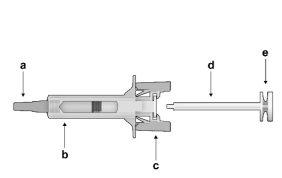
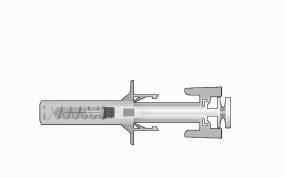
Figura1: | Seringa de segurança: Antes do usoa) protetor de agulha
| Seringa de segurança: Após o uso(Com o mecanismo de proteção da agulha ativado) |
Ter em mente que o volume de injeção menor é apenas visível na janela de visualização, pois o resorte do dispositivo de segurança está “cobrindo” uma parte do cilindro de vidro que está perto da agulha. |
- NÃO TOQUE AS ASAS DE PROTEÇÃO DA SERINGA ATÉ QUE VOCÊ ESTEJA PREPARADO PARA SE INJETAR. AO TOCÁ-LAS, O PROTECTOR DA SERINGA PODE SE ATIVAR DEMASIADO CEDO.
- NÃO USE O PRODUTO SE ELE TIVER CAÍDO SOBRE UMA SUPERFÍCIE DURA OU ESTÁ DANIFICADO. USE UM PRODUTO NOVO PARA A INJEÇÃO.
- Administração
- Remover a seringa da caixa de cartão: pegar a seringa pelo corpo protetor.
- Segurando firmemente a seringa pela janela de inspeção, introduzir a vara do êmbolo no topo do êmbolo fazendo girar suavemente a vara do êmbolo no sentido horário até que fique segura (ver Figura 2).
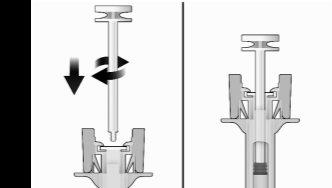
Figura2 | Antes | Depois |
- Inspecione a seringa de segurança com atenção:
- Não use a seringa de segurança após a data de validade que aparece na caixa de cartão ou na etiqueta da seringa.
- É possível ver uma pequena bolha de ar, o que é normal.
- O líquido deve ser transparente. Não use a seringa de segurança se o líquido contém partículas ou está turvo.
- Escolha a zona de injeção. É necessário rotar a zona de injeção entre glúteos, coxas, abdômen ou braços (ver Figura 3), esperando pelo menos 8 semanas antes de voltar a injetar em um local utilizado previamente. É necessário evitar as injeções na cintura ou a menos de 5 cm do umbigo.
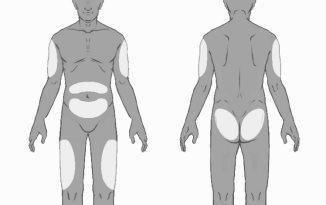
Figura3
- Coloque luvas e limpe o local da injeção com movimentos circulares usando uma gaze com álcool (não incluído no envase). Não toque novamente na zona limpa antes da injeção.
- Segurando a seringa de segurança pelo corpo protetor da seringa, como mostrado (ver Figura 4), puxe diretamente para fora do protetor de agulha com cuidado. Descarte o protetor de agulha imediatamente (não tente nunca colocá-lo de volta). É possível que haja uma gota de líquido na ponta da agulha. Isso é normal.
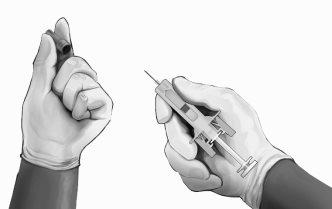
Figura4
- Pegue a pele no local da injeção entre os dedos polegar e indicador, como mostrado (ver Figura 5).
- Segure a seringa de segurança como mostrado e introduza suavemente a agulha em um ângulo de 90°, aproximadamente (ver Figura 5). Empurre a agulha até que penetre completamente.
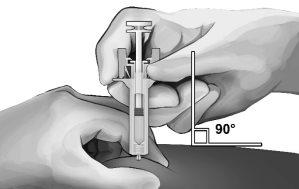
Figura5
- Segure a seringa como mostrado (ver Figura 6), pressione lentamente o êmbolo até que a cabeça se trave entre as asas de proteção da seringa e toda a solução seja injetada.
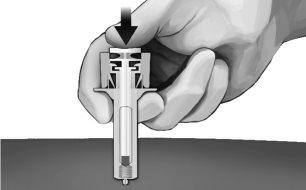
Figura6
- Retire suavemente a agulha da pele. É recomendável que o êmbolo seja mantido completamente pressionado enquanto a agulha é retirada com cuidado da zona de injeção (ver Figura 7).
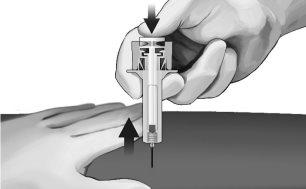
Figura7
- Assim que a agulha for retirada da pele, retire lentamente o polegar do êmbolo e deixe que o protetor da seringa cubra automaticamente a agulha exposta (ver Figura 8). É possível que haja uma pequena quantidade de sangue na zona de injeção; se necessário, limpe com uma bola de algodão ou gaze.
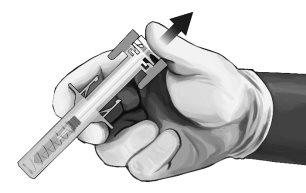
Figura8
- Eliminação da seringa
A eliminação do medicamento não utilizado e de todos os materiais que tenham estado em contato com ele será realizada de acordo com a normativa local.
- País de registo
- Substância ativa
- Requer receita médicaSim
- Fabricante
- Esta informação é apenas para referência e não constitui aconselhamento médico. Consulte sempre um médico antes de tomar qualquer medicamento. A Oladoctor não se responsabiliza por decisões médicas baseadas neste conteúdo.
- Alternativas a BUVIDAL 16 mg SOLUÇÃO INJETÁVEL DE LIBERTAÇÃO PROLONGADAForma farmacêutica: INJETÁVEL, 128 mg/0.36 mlSubstância ativa: buprenorphineFabricante: Camurus AbRequer receita médicaForma farmacêutica: INJETÁVEL, 160 mgSubstância ativa: buprenorphineFabricante: Camurus AbRequer receita médicaForma farmacêutica: INJETÁVEL, 50 mg/mLSubstância ativa: buprenorphineFabricante: Camurus AbRequer receita médica
Alternativas a BUVIDAL 16 mg SOLUÇÃO INJETÁVEL DE LIBERTAÇÃO PROLONGADA noutros países
As melhores alternativas com o mesmo princípio ativo e efeito terapêutico.
Alternativa a BUVIDAL 16 mg SOLUÇÃO INJETÁVEL DE LIBERTAÇÃO PROLONGADA em Ukraine
Médicos online para BUVIDAL 16 mg SOLUÇÃO INJETÁVEL DE LIBERTAÇÃO PROLONGADA
Avaliação de posologia, efeitos secundários, interações, contraindicações e renovação da receita de BUVIDAL 16 mg SOLUÇÃO INJETÁVEL DE LIBERTAÇÃO PROLONGADA – sujeita a avaliação médica e regras locais.











